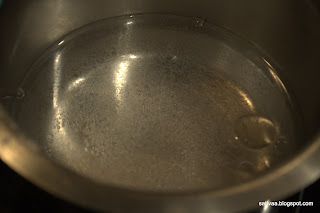Hope everyone had a good weekend, we had a good one starting with the Varalaksmi festival on Friday. There has been some planning going into the pooja preparation and menu finalization for the past week or so, now that my in-laws are here with us, we have 2 additional brains for menu ideas :-). Amma said we had to make 9 varieties for the naivedya/naivedyam (offering to God after the pooje), so I kind of tried to pick atleast one each of everyone's favorite in addition to the traditional must-haves and we actually ended up with a wonderful spread of dishes and all of us including some friends who came in the evening enjoyed the food.
Food is such an integral part of any festival, right? I notice it is true without any barrier of region or religion. I guess, for me that is where my earliest food related memories are, any festival or get together at home, nammamma would be up early and in the kitchen preparing variety of dishes, there were days on which we kids were strictly forbidden from entering the kitchen and my uncle would be in charge of driving any stray kids away from the place, I even remember him writing 'No Entry' on the kitchen door to drive home the point :-). Some of the festivals, nammamma would prepare things ahead of time (Sankranthi ellu being one of them) but most times, she would cook the naivedya dishes only on the day of the festival after bathing. We prepared all of the naivedya dishes on Friday morning too and so the pooje started a little late and took us right into lunch time which was perfect. We were famished, food was good and we had a great time.
Here is a quick look at our naivedyam thali(s), I will try to get all of them into the blog as soon as I can. Though I took the pictures for every dish, I don't have enough of them especially for a stand alone blog post, so some of them will be featured only when I make it next time :-).
But today's post is dedicated to a traditional Andhra delicacy - poli purnam boorelu. The name is a mouthful, so let me break that out for the uninitiated. Poli~steamed, purnam~sweet stuffing. This is a sweet prepared in weddings and other auspicious occasions, the process is slightly laborious but the end result will simply mesmerize you with taste. Ingredients are simple, used every day in the kitchen. There is another very popular form of boorelu with the chana dal stuffing (my personal favorite only because I like jaggery based sweets more than those made with white sugar) which is simply called purnam boorelu but the poli purnam boorelu is equally delicious.
The stuffing is made with moong dal, sugar and lot of cardamom(yes, use lots and freshly pounded for flavoring), the outer shell is made with a dosa like batter made with urad dal and rice. Stuffing is dunked in the batter and deep fried to a golden brown, crispy perfection. I am told that this is traditionally eaten by making a hole in the middle of a hot, crispy boorelu and adding a spoonful of ghee before popping it into the mouth. Although, we didn't go to that extreme indulgence, we completely enjoyed the sweet, cardamom flavored, protein packed boorelu.
What do you need to make Poli Purnam Boorelu?
The proportions below make about 18-20 golf ball sized boorelu.
Ingredients for stuffing:
1 cup moong dal/pesara pappu
3/4 cup sugar (adjust to taste if you like sweeter)
4-5 cardamom - peeled and seeds freshly pounded
Ingredients for covering:
1/2 cup urad dal/uddi pappu/minapappu
1 cup rice
Other ingredients:
Oil to deep fry
How do you make Poli Purnam Boorelu?
Making the stuffing:
Food is such an integral part of any festival, right? I notice it is true without any barrier of region or religion. I guess, for me that is where my earliest food related memories are, any festival or get together at home, nammamma would be up early and in the kitchen preparing variety of dishes, there were days on which we kids were strictly forbidden from entering the kitchen and my uncle would be in charge of driving any stray kids away from the place, I even remember him writing 'No Entry' on the kitchen door to drive home the point :-). Some of the festivals, nammamma would prepare things ahead of time (Sankranthi ellu being one of them) but most times, she would cook the naivedya dishes only on the day of the festival after bathing. We prepared all of the naivedya dishes on Friday morning too and so the pooje started a little late and took us right into lunch time which was perfect. We were famished, food was good and we had a great time.
Here is a quick look at our naivedyam thali(s), I will try to get all of them into the blog as soon as I can. Though I took the pictures for every dish, I don't have enough of them especially for a stand alone blog post, so some of them will be featured only when I make it next time :-).
But today's post is dedicated to a traditional Andhra delicacy - poli purnam boorelu. The name is a mouthful, so let me break that out for the uninitiated. Poli~steamed, purnam~sweet stuffing. This is a sweet prepared in weddings and other auspicious occasions, the process is slightly laborious but the end result will simply mesmerize you with taste. Ingredients are simple, used every day in the kitchen. There is another very popular form of boorelu with the chana dal stuffing (my personal favorite only because I like jaggery based sweets more than those made with white sugar) which is simply called purnam boorelu but the poli purnam boorelu is equally delicious.
The stuffing is made with moong dal, sugar and lot of cardamom(yes, use lots and freshly pounded for flavoring), the outer shell is made with a dosa like batter made with urad dal and rice. Stuffing is dunked in the batter and deep fried to a golden brown, crispy perfection. I am told that this is traditionally eaten by making a hole in the middle of a hot, crispy boorelu and adding a spoonful of ghee before popping it into the mouth. Although, we didn't go to that extreme indulgence, we completely enjoyed the sweet, cardamom flavored, protein packed boorelu.
What do you need to make Poli Purnam Boorelu?
The proportions below make about 18-20 golf ball sized boorelu.
Ingredients for stuffing:
1 cup moong dal/pesara pappu
3/4 cup sugar (adjust to taste if you like sweeter)
4-5 cardamom - peeled and seeds freshly pounded
Ingredients for covering:
1/2 cup urad dal/uddi pappu/minapappu
1 cup rice
Other ingredients:
Oil to deep fry
How do you make Poli Purnam Boorelu?
Making the stuffing:
- Soak moong dal in 3 times water for 2 hours.
- Wash and drain the moong dal, grind it with as little as possible water to a paste.
- Put spoonfuls of the ground paste into idli moulds and steam it for 15 minutes until the dal is cooked.
- Once the steamed cakes cool down, break them into pieces and run it through your mixer on pulse mode to further break them, add the sugar and blend it once with the dal.
- This mixture will be slightly wet because of the added sugar, add the freshly pounded cardamom and working with your hands, knead the entire mixture for a couple of minutes until the consistency is good to make balls out of it.
- Make golf sized balls with this mixture and keep aside.
Making the covering:
- Soak the urad dal and rice together in water for 3 hours until they soften.
- Wash, drain the dal-rice mixture and grind it in the mixer into a batter. Add water while grinding but make sure you get a dosa consistency batter at the end.
- This batter doesn't have to ferment and does not have to be overly smooth. Keep aside.
- Heat the oil for deep frying preferably in a wide pan. Check the readiness by dropping a small droplet of the batter in the oil, if it comes right up to the surface, oil is ready.
- Take the prepared stuffing ball, dunk it in the batter, shake it to remove any extra batter and drop it carefully in the hot oil. Repeat for the remaining stuffing to just fill your frying pan.
- Leave the boorelu to cook untouched for a couple of minutes before slowly turning them over to cook on the other side.
- When the boorelu reach a golden brown crust on all sides, take them out of the oil onto a paper napkin.
Notes:
- Do not soak moong dal for more than a couple of hours as it tends to become oily when fried.
- Breaking the steamed moong dal idlis into fine powder along with sugar takes some hard work with your hands, make use of the mixer to pulse it down as much as possible before manually kneading it to make balls.
- The batter covering should be flowy but not watery, it should coat the stuffing well at the same time not becoming very thick, adjust the consistency as needed.
- Use fresh pounded cardamom for best flavor burst.
- You can make dosas with any extra batter, i added a spoonful of fine sooji, salt and the dosas were delicious.




















































